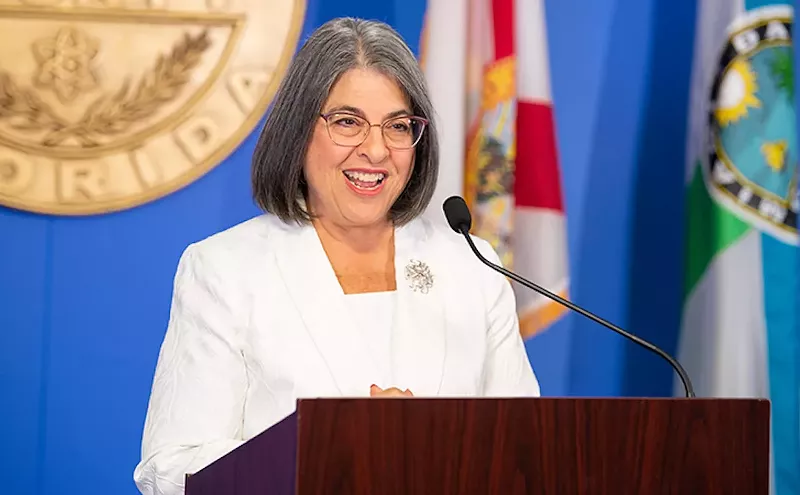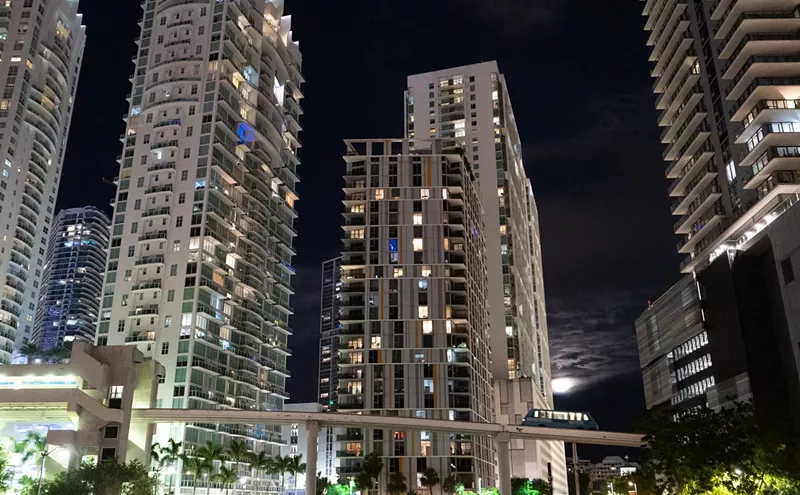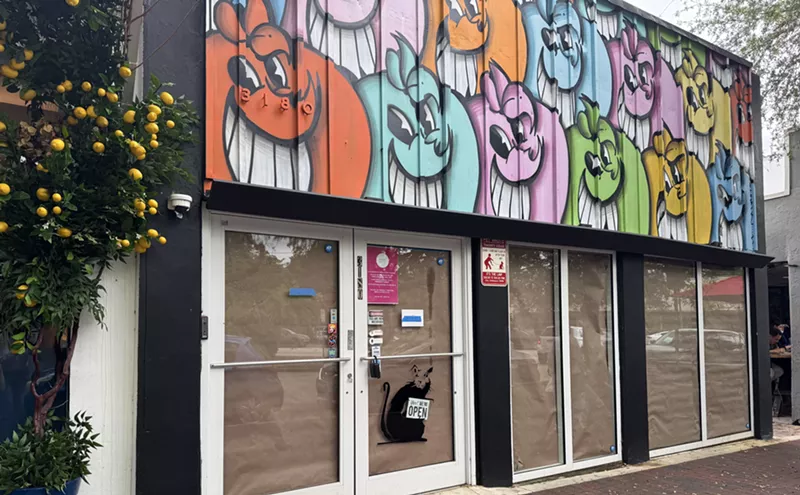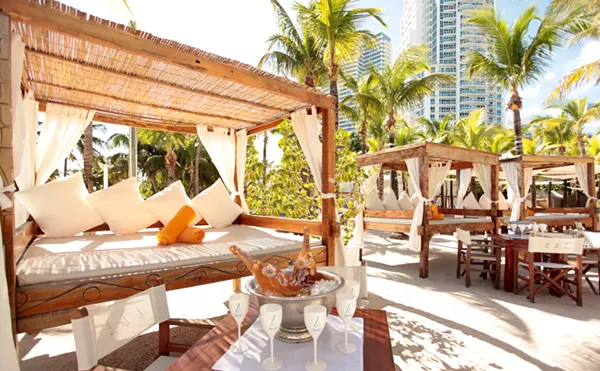His thin, 81-year-old frame draped in a tan suit, his sharp eyes shaded by wraparound sunglasses, Tibor Hollo stands before a rusted fence bearing a spray-painted "No Trespassing" sign.
Beyond the chainlink, strewn with weed-choked bottles and crushed cans, two of the finest acres in Miami stretch to the edge of Biscayne Bay, where turquoise water laps against a concrete barrier and Fisher Island swims on the horizon.
Hollo has just given it all away.
He looks on quietly as Miami Commissioner Marc Sarnoff strides smiling to a shaded podium to announce the deal: For three years, the city gets the land for one dollar a year and the promise to maintain a public park there. Mayor Manny Diaz applauds and grins for the cameras.
After he watches the fanfare pass and firmly rejects an offer to name the place "Hollo Park," Tibor is blunt. "This is not the market to start a major project," he tells a reporter, his thick Hungarian accent transforming short i's into long e's. "At least someone will enjoy this place for a few years."
No moment better captures the Zeitgeist of the South Florida condo bust than this, the legendary developer handing over land that his competitors would have killed for a few months ago. It's now worthless, sunk by a burst bubble so profound that entire 30-story condo buildings rise dark above the bay and more than 25,000 units languish on the market.
As much as anywhere in the United States, this region is ground zero for the real estate meltdown that has decimated the global economy and sunk this nation into its worst recession in 80 years. More than 100,000 single-family homes, condos, and townhouses sit vacant in the greater Miami area; over half of them are new foreclosures filed in the past year. To put it into perspective, South Florida has seen more than $14.2 billion worth of property foreclosed in the past year alone — an all-time record.
But the numbers tell only part of the story. In places such as West Kendall and Homestead, whole blocks sit empty, spray-painted plywood slapped over windows and saw grass creeping over driveways. Squatters and prostitution rings have moved into vacant homes. Companies hired to clean out abandoned residences pile belongings in front yards, letting neighbors pick through remnants of someone else's life.
Signs of impending doom are everywhere, even in areas such as downtown Miami and South Beach, where huge banners offering cut-rate deals hang from high-rises. Condo boards have a hard time keeping vagrants out of the stairwells of half-empty buildings. Some landlords have become so desperate they've taken to renting out luxury units to porn film crews at daily rates just to keep the lights on.
Hollo has seen it all before. In fact, the building boom that preceded this bust would never have happened without the extraordinary vision of the Holocaust survivor who at age 29 moved to South Florida in the mid-1950s and told anyone who would listen that, someday, white-picket-fence suburbs would fade and towering downtown condos would be the norm in the Magic City. Without Hollo, it's doubtful the skyline that defines 21st-century Miami — for better or for worse — would exist.
Hollo knows local real estate as well as anyone — he has been through its booms and busts — and he is convinced the city will bounce back. Indeed, he's betting everything he's right and plunging millions of dollars into his next project: a thousand-foot tower downtown on Biscayne Boulevard. It would be the tallest ever built in the area.
This is where to find the architect of modern Miami: past a faded black marble waiting room, around some unremarkable cubicles, and tucked into a corner on the ninth floor of a drab 19-story tower just south of Flagler Street on Biscayne Boulevard. It's an easy building to miss, sandwiched between two office towers twice as tall, decades newer, and sheathed in sparkling glass. For 20 years — ever since he bought and renovated the building — Hollo has worked here. This morning, he sits behind a wide wooden desk, near piles of paper rising around his keyboard. For one of Miami's most successful entrepreneurs, it's a Spartan office; the closest thing to luxury is the long window with eye-popping, unobstructed vistas of Bayfront Park and the aquamarine bay dotted with sailboats. But Hollo tries not to dwell on the view.
"I had to move my desk so it was facing away from these windows," Hollo says. "When I faced the outside and I could see all the ships coming in and going out, I would daydream all day long."
When Hollo does look along the bay — north past the Omni/performing arts neighborhood, south to Brickell — he sees those daydreams made reality. From his first success, a small apartment tower with pointed concrete balconies just north of the Rickenbacker Causeway, to his latest project, the white cylindrical Opera Tower, Hollo has personally developed dozens of Miami projects and more than 55 million square feet of real estate. Under his gaze — and because of his faith in the city — downtown has transformed from a comatose 1950s office district into a burgeoning international hot spot of skyscraping glass monoliths.
The past 12 months have ranked among the toughest in Hollo's 55 years as a developer. He has sold only about 38 percent of the condos in his multimillion-dollar Opera Tower, which opened last year. To stay above water on the building, he's renting out the rest of the units for as low as $950 a month.
It's much worse for other developers who took out higher loans and presold fewer units. Condo owners and developers, desperate to get the cash flowing to keep mortgages and construction loans intact, are trying everything: giving away Lamborghinis and Mini Coopers with purchases, slashing prices in half, selling units in bulk packages to vulture firms or equity groups.
Condo owners who bought at the top of the market, meanwhile, steam while their neighboring units are rented out at pennies on the dollar and their condo associations struggle to scrape together enough cash to keep basic services such as garbage collection and maintenance. Many now owe more on their mortgages than their condos are worth; others have simply thrown in the towel and succumbed to foreclosure.
Hollo shakes his head and raises his voice above the usual smoky lower register as he names those to blame for the latest mess: Wall Street tycoons, Bernie Madoff, and bad investors. Even when he's angry, Hollo drips with congeniality, punctuating his jokes with a booming laugh and illustrating his points with personal stories from a long life.
The ones most at fault in this bust, he says, are the inexperienced and the unscrupulous who flocked in droves to the region during the middle of this decade, as subprime loans, lax oversight, and outright fraud pumped America's housing bubble to increasingly absurd heights.
"There are lots of professional developers in the industry, and some of them are very good," Hollo says. "But there are also lots of what I call 'dentists from New York,' who don't know a damn thing. They could see people were making money here, so they buy land and they jump into business without knowing anything."
Miami's condo market followed the nationwide housing frenzy that gripped the United States after the post-9/11 mini-recession ended in 2002. With mortgage giants Fannie Mae and Freddie Mac throwing around loans like party favors and banks following their lead, housing prices exploded. The area's bubble was one of the six or seven largest in the country, with homes appreciating by more than 80 percent between 2001 and 2006.
As housing prices spiked, towering cranes climbed like kudzu. For four years, between 2002 and 2006, every "dentist from New York" with a few million to invest backed a project here. Construction began on more than 20 new luxury condo high-rises, most with hundreds of units. Every week — sometimes every night — developers threw waterfront galas studded with celebrities and soaked with free champagne and cocktails, while stunning architects' renderings of their grand plans flashed on movie screens.
It wouldn't last.
"There was speculation that came with all the exuberance," says Michael Cannon, a real estate analyst and consultant. "Unfortunately, there's a fine line between speculation and larceny."
With a nearly audible pop, the housing bubble collapsed nationwide in late 2006. For South Florida's condo projects, the effect was devastating. Many had secured bank financing by preselling a huge percentage of their units to investors, who bought as many as they could while the market was rising, with plans to flip them. When credit disappeared, reams of those investors defaulted or lapsed into foreclosure.
"It was the perfect storm of hype, fluff, and optimism, coupled with greed, avarice, and fraud that artificially inflated values and produced this overdevelopment," says Jack McCabe, a real estate consultant and researcher.
Today, eight of the approximately 20 towers opened in the past two years have sold less than half of their units, and only six have closed more than 80 percent, according to Lucas Lechuga, a realtor who compiles condo closings on his website. Several are still trying to unload more than three-fourths of their condos.
"I still think there's another round of foreclosures to come," Lechuga says. "We have another year, until the end of 2009, before we hit rock bottom. And then prices still aren't going to improve for a long while."
Among the 21 condo buildings opened in the past two years that Lechuga has tracked, Hollo's Opera Tower has the fourth-lowest percentage of condos sold. But Hollo says he has weathered the storm thanks to the lessons he learned in the past.
For one, his firm — Florida East Coast Realty — tackles only one project at a time and takes out comparatively low 40 percent bank loans. Many developers borrow at 80 or 90 percent of the cost of their project. The result of this prudent financing, Hollo says, is that he can rent units in the tower until they sell and still make his loan payments.
There are no public records to confirm Hollo's cash flow. But no liens have been taken out against his company or the Opera Tower project, and he has never recorded any bankruptcy claims. Real estate experts say his explanation of how he has survived the bust sounds reasonable. "Tibor's been through this process so many times," McCabe says, "it's possible he foresaw the crisis."
"You know those animals in California who can sense an earthquake coming before it happens?" asks Tibor, clasping his bony hands behind his head and leaning back in a reclining desk chair. "This is the ninth time I've been through this cycle, and back in 2006 I got that feeling: Something is not right here."
Tibor Hollo was born in 1927 in Budapest, Hungary, but grew up in France until Germany invaded Poland and World War II erupted across the continent. In early 1941, the Jewish Hollos were arrested and sent to Drancy, a concentration camp just outside Paris. Tibor was 14 years old.
After a few months, the French shipped the Hollos to a Nazi death camp. The family was held briefly at Auschwitz, where Tibor and his father were separated from his mother. He never saw her again.
"My mom, rest in peace, was killed before we were forced to march to Mauthausen, Austria," Hollo says.
Hollo and his father survived the long, cold trek and found a way to survive at Mauthausen, a camp of 85,000 prisoners in northern Austria, until soldiers from the U.S. 11th Armored Division arrived May 5, 1945. Even today, Hollo has difficulty talking about his time in Nazi hands.
"I was very young, so it's hard to say what kind of effect the experience really had," Hollo says. "I was 14 when I went in and 17 when I came out. I know those are formative years, but I can't say if my time there changed me. How would I know?"
After his liberation, Hollo made his way back to France, where he earned an architecture degree and saved up enough money to buy passage on a sea voyage to Ellis Island. He landed in New York with $18 in his pocket and a degree that impressed no one.
He started work in a curtain factory and eventually found a job as an estimator for a general contractor. The company routinely turned down contracts on New York's rough waterfront, and as Hollo worked his new job, he came to a quick realization. "I found out that working the waterfront was difficult and very scummy work, and not many contractors would bid on it," Hollo says. "So after I put together a few hundred dollars, I quit and started my own firm and underbid the few contractors interested in that kind of work."
When Hollo showed he could get projects completed on time and at a low cost, and he was willing to work in tough areas that didn't attract many other businesses, his workload exploded. A few bids in lower Manhattan turned into larger contracting projects around New York City, which turned into bids from Detroit to San Francisco. By 1956, Hollo's contracting company was one of the ten largest in the United States. But the work was also exhausting, and at 29 years old, Hollo decided it was time to start over.
On a business trip to Florida to work on a project at Cape Canaveral, Hollo fell in love with the Sunshine State. He sold his contracting business, left New York, and moved to Miami, eager for a fresh start. He would use his savings not to open a new contracting firm, but to become a developer. His friends thought he was crazy.
"Some people dream and conceive. And other people can put those dreams on paper, and that's the blueprint. And then other people can go out and realize the blueprint and make it reality," Hollo says. "But as a developer, I get to be all those people. I get to dream it and then make it real. It's incredibly satisfying, and that's what I wanted to do."
When Hollo arrived in 1956, Miami had already seen several dramatic cycles of boom and bust. For 130 years, South Florida's gently swaying palm trees, clean ocean air, and miles of blue water had lured investors to Biscayne Boulevard, Brickell Avenue, and South Beach. In the roaring '20s, developers built Mediterranean and Middle Eastern fantasies in Coral Gables and Opa-locka, and dreamers dredged up the bay to create the Venetian Islands. Speculators hopped every train south to the Magic City to get a piece of the action, but by the end of the decade, the party was over. Half-built subdivisions would rot and projects would fall into disrepair for almost 20 years, until the Great Depression and World War II had passed.
Hollo's dream was to bend Miami, then a still-budding metropolis, to his vision for the future. That vision wasn't shared by returning GIs who used their government pensions to move to faraway suburbs and buy big cars. "I looked at Miami and I said this city is going to grow, but it's a linear city," Hollo says. "You can only grow north-south, not east-west, because of the water and the swamps. And at some point, you're going to have to grow vertically, because you're going to run out of north-south."
Hollo's career as a developer began modestly but successfully, with midtown office buildings and apartment complexes. As his business grew, he started lecturing at colleges about the day when high-rise, "multipurpose" buildings downtown would replace suburbs straddling the Everglades.
Hollo remembers speaking at a civic meeting soon after moving to Miami, pitching a plan to build a tunnel under the Miami River to fuel the city's expansion south into Brickell.
"Those sons of bitches laughed me out of the room," he says.
Within five years, however, the city changed its tune and invested millions into raising a new bridge over the river, and Hollo developed a high-rise office tower in the area, at 888 Brickell Ave. That building's success showed the dream was possible.
But it was in 1968 when his dream of a high-rise residential city took its biggest step forward. That year, he began a three-year effort to buy six city blocks of waterfront property next to the Venetian Causeway, a mostly blighted section that included a Rambler dealership, an old movie theater, and overgrown parking lots. Today, that area is known as the Omni/performing arts neighborhood.
"This was an area of slum and blight," says Phil Yaffa, who spent 18 years as a top official in Hollo's company. "But he saw through that and realized that the future in this city was in a dense vertical concentration within the downtown area."
At the time, downtown Miami boasted a few hotels, big department stores, and office buildings, but few residential areas. Hollo had a plan for his land by the bay: Transform it into a place where people could live, work, and play. But to make it reality, he had to persuade city leaders to close streets in the area, change zoning laws, and offer huge tax breaks. It wasn't an easy sell in the still-suburb-crazy late '60s and early '70s.
"I told them I wanted to make a multi-use building, where people can work, recreate, and live," Hollo says. "The city had no such things. You built an office building or a store or an apartment. It just wasn't in the vocabulary."
Hollo found a vital ally in 1973, when Maurice Ferre, the son of a Puerto Rican developer, was elected mayor of Miami. Ferre says he bought into Hollo's vision after their earliest meetings.
"In those days, unlike today, overgrowth was not a factor. There was just the opposite; there was no growth," Ferre says. "That's when Miami was really dead. At that time, there was very, very little in downtown, which is why I was so in favor of Tibor's plan. It became a stimulant for all these other projects."
With Ferre's backing, Hollo persuaded the city commission to close two city blocks so he could build the Omni Mall, and willed the commission into backing the 810-condo Venetia tower with a full marina.
Hollo could be as tough behind the scenes as he was charming in public. According to a Miami Herald story, Hollo wanted 1,000 units and threatened to abandon the whole project if the city, which wanted to green-light only 500, didn't cave. "I'll go fishing," he told a reporter who asked what he'd do if the commission stood firm.
Another major critic was Trinity Episcopal Church, which was surrounded by his massive project and didn't want a busy marina added to the nearby waterfront. But after a several-year battle over marina permits, Hollo won.
"Whatever Tibor wanted, Tibor Hollo got," Minnette Massey, an attorney representing the cathedral, complained to the Herald at the time.
Even more important, with Ferre's political capital, Hollo carved out Miami's second tax-increment financing zone on his land. The TIF, as it's known, was at the time a radically innovative tax plan that had been launched just a few years beforehand in Overtown. It basically used property taxes raised in the neighborhood to improve streets, utilities, and infrastructure on Hollo's land.
Critics hammered Hollo for negotiating such a beneficial deal with the city and for ushering in a new era of big buildings on the waterfront.
"More setbacks, more open space in an effort to preserve views of the waterfront" would have made for a far better precedent, Richard Whipple, a city zoning official, told the Herald.
"[Hollo built] big, bulky, inimical buildings that are foreboding to look at and unpleasant to walk around," Beth Dunlop, the Herald's architecture critic at the time, argued. "An enlightened city commission would have sent Hollo and his colleagues back to the drawing boards. And not to do a new project, but to design it better. To fashion a complex that would be enticing to pedestrians, that would not have turned North Bayshore into a lifeless abyss, that would not look like a series of high-rise warehouses for the rich."
But Ferre says he never had any regrets about jumping onboard with Tibor's controversial idea.
"I always believed in Tibor. I always thought he was an honest and righteous guy, and there was no bullshit about him," says Ferre, who left the mayor's office in 1985. "He was a real charmer, but he wasn't a bullshitter, and there's a big difference. He had the courage to build this project, which was completely out of scale of what Miami was in those days."
"Taste and beauty are in the eye of the beholder," Hollo says today, pointing out that Venetia placed in national architecture competitions. As for those blocked waterfront views, Hollo says he has always included more than 100 feet of space between his projects; many South Beach hotels are crammed to within 30 or 40 feet of each other.
For all his courage, there's no doubt that Hollo has often been ahead of his time — or, to put it another way, has lacked timing — on some of his most ambitious projects. By the time his huge Venetia condominium hit the market in the late 1980s, Miami was on the down end of one of its worst boom-and-bust cycles since the 1920s.
The South American economy, which had driven mountains of investment in Miami, had completely collapsed. And by 1988, two years after entering the market, Hollo had sold only 57 of the Venetia's 810 units, according to the Herald — a shockingly dismal 7 percent.
"He was a little premature," says Matthew Schwartz, who was head of the Downtown Development Authority in the late '80s and early '90s. "The image of downtown still hadn't caught up with Tibor's vision. I think financially he had a difficult few years because he was too far ahead of times."
"It was devastating. It was a terrible, terrible time," Yaffa recalls. "We worked seven days a week, 12-hour days, trying to do everything we could to generate sufficient sales and to successfully complete this building."
Hollo eventually reached an agreement with his bank, working out a three-way deal to transfer most of the building's ownership to a new group and reaping little of the financial benefit as the Venetia, along with the neighboring Grand, eventually turned into the successful complex it is today. But he also kept his business intact and lived to develop another day.
"My bank, which was a wonderful bank, saw me really struggling and said... 'Why don't we make a deal?'" Hollo says. "It was a really tough time, but it taught me to be conservative. I can do one building at a time. Why do I need ten? I can buy my wife a glass of wine and go out to dinner; life is good and one is enough."
Despite those trying times, Hollo says he never lost faith in his core beliefs. Americans would eventually move back to their city centers. They would want to live and work in multi-use buildings with beautiful views and easy access to cultural events. It was just a matter of timing.
Even with a new, even more troubled era dawning over Miami, that faith hasn't faded.
Hop into a raft and motor through Biscayne Bay early some morning, just after the sunrise warms orange and pink into the slate sky, and head north along Miami Beach's shore just past Mount Sinai Medical Center. More than likely, Tibor Hollo will be there, slicing through the choppy water with the same methodical stroke that has carried him through the bay for 55 years.
His path hugs the shoreline, parallel to the wooden docks, the million-dollar yachts, and the multimillionaires' mansions, his tanned and trim frame eventually circling back to the same home he built on North Bay Drive in the late 1950s. Hollo's daily morning swims, as much as anything, convince him that Miami's dark days will never linger.
"We have more usable water here than any city in America," Hollo says. "I love all this water that's so warm year-round. I did some project in San Francisco and it's surrounded by water, but it's not the same. I can't swim there!"
The legacy this Hungarian immigrant has created in his adopted hometown is difficult to dispute. His projects read like a history of Miami development: from 888 Brickell to the U.S. Justice Department Building to the Vizcaya Towers to the Venetia/Grand complex to Bay Parc Plaza.
"He really anticipated the move toward downtown residential living, and his vision helped create this boom in Miami," says Paul George, a Miami historian with the Historical Museum of Southern Florida.
To many critics, there's a cost that has come with that vision. Early opponents of Hollo's Venetia/Grand complex complained the bay-front high-rise acted as a wall between the city and its waterfront. There's no doubt that today, after so many developers have followed Tibor's vision, there are fewer and fewer links between downtown Miami and its water.
"He's the pioneer of residential downtown, with this vision of a Hong Kong, 24-hour, dense downtown," says real estate analyst and consultant Michael Cannon. "Is downtown already too dense because of this vision? Yes. Miami is a great cosmopolitan area, but it's no Hong Kong."
Some detractors have questioned the artistry in his buildings, with one architect initially deriding the Venetia/Grand as an "elephant standing on a ping-pong table."
"With the Grand, the Marriott, the Venetia, it's pretty generic stuff, not very distinctive," George says.
Hollo has also had his tussles through the years. His style tends toward charm and deference in public, but he usually wins battles in private — such as when he overcame public outcry and many civil leaders' opposition to build the Venetia complex.
Just last year, Hollo took a rare public strong stand, suing Lucas Lechuga, the real estate blogger, for $25 million for falsely reporting he'd gone bankrupt in the 1980s. The two settled, and Lechuga posted a public apology to Hollo on his site last month.
"A developer has to be a cheerleader, a visionary, and a gunslinger. If you don't have all three, it's not going to happen," says Peter Zalewski, founder and owner of Condo Vultures, a firm that buys distressed condos for a discount and resells to investors. "Tibor, without a doubt, is all three of those things."
But as his predictions of a generation that would abandon the suburbs for downtown high-rises have come to pass, and as his decades of development have refined his style, Hollo's critics have mostly fallen by the wayside.
Regardless of how Miami got to this low point, Hollo says the real estate market will recover, probably in two years, but possibly not until 2011. He says that, eventually, the city's scores of empty condos will be full of people. And when that happens, he's betting that the market for downtown office space will be squeezed. And that's where his final project comes in, his lasting legacy to the city: One Bayfront Plaza.
On the very site at Biscayne and Flagler where Hollo's comfortable if unremarkable office tower sits, he wants to construct a 1,010-foot, twisting, windblown sail of a building. He has already plunged $35 million into studies, permits, and architectural plans for what would be his masterwork.
Those who know Hollo best say it's not the money or the prestige of such a massive project — the final cost is expected to reach $1.8 billion — that has excited the developer.
"If it was up to Tibor, he would be driving a 20-year-old car and living in a modest home," Yaffa says. "I don't know if money ever motivated him as much as his sincere love of this business and the challenges and problems it presents, and opportunity for him to meet those challenges."
This is also the same guy who donated bay-front land to the city and then refused to let the park be named after him. Hollo says his primary motivation, in fact, is gratitude with a healthy dose of civic one-upsmanship.
"Miami, for as far as it's come, does not have a signature building," Hollo says. "That's what One Bayfront Plaza can be. This city has given me an awful lot, and I want to give it an icon, to leave a legacy for this city."
But it's also simpler than that. Leaning back behind his desk, lost in a thick-knit brown sweater, Hollo says there's one motivation everyone overlooks: He's building Miami's tallest tower because he knows it will work.
"It's going to be the end of 2012 or the beginning of 2013 before construction begins," Hollo says. Construction will take about three years, so the building isn't likely to open before 2016. "That's seven years. Christ, if this market isn't back on track seven years from now, you and I may as well both go shine apples for a living."












